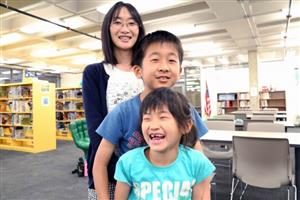
-
Our school corporation relies on an extremely diverse community; culturally, economically, and through a vast set of different experiences. Our faculty attempt to learn from these differences everyday and contextualize them within our student's education. This is a collection of stories from individuals around Columbus and within our schools to help faculty, parents, and students understand each other and build empathy.
-
Culture shock: not just for students!
Posted by Whitney Grant on 4/21/2017 12:00:00 PM
Working in schools it becomes easy to spot the new kid. Their “deer in headlights” expression says it all. But it can be hard to do the same for parents. As locals, we have many expectations that just do not jibe with foreigners, whether they are new-comers or not. This mix of expectations can be very frustrating for all parties involved and can ultimately make life more difficult to the most important of these parties: the student.
The American education system has many tricks that are not standard in many countries. The most infamous of which is affording post-secondary education. Standardized testing can be a struggle as well. Cultural differences can play a part in the basics of how children learn too. Cultures as varied as Japanese to Mexican are taught in school to focus on memorization rather than critical thinking. Asians in general are less inclined to participate in sports in favor of formal study. Similarly, many European countries separate school from extracurricular groups, since entry into University is less dependent upon extracurricular participation as it is in the United States. Even the G.P.A. can be misinterpreted by some as being relevant to the entire student’s performance (with respect to College entry), while others do not understand its significance at all.
Once during a parent/teacher conference I had regarding a student’s failing grades and lack of attendance, the foreign parent was very disappointed with his son’s performance and willing to help. The conference revealed that the student was working minimal hours at a restaurant and thriving in his culinary C4 classes, but was going out with friends until late at night. When we trouble-shot with the parent about how he could manage his time better in order to turn in his assignments and be more alert in class, the parent was determined to make him stop working. The educators were surprised by this solution given he was spending so much time with his friends. When we suggested cutting down the number of nights he could go out, the parent said, “I can’t do that! This is his youth. He is supposed to go out and have fun now.”
While I disagreed with this parent’s assessment, I can understand how strange the demands on our students must seem to other cultures. Or for others, how relaxed they think we are. The important thing is that parents and teachers have an open dialogue about expectations, norms, and opportunities. It is clear that schools need to engage their families and provide more information about how they function. On the flip side, parents also need to feel that they can explain their concerns and share some of their student’s assets whether they are cultural or intellectual. Finally, these kids who are trying their hardest in school can be taught the advantages of being different, how to own it and some of the tricks that other foreign nationals have learned to help cope with all of these changes.
Travelling the world is a wonderful blessing, but living the day to day of a global citizen, much less a global student can be exhausting. Let’s think of ways that the school can reach out and engage those families and make them as successful as they can be.
-
Summer is Fast Approaching
Posted by Whitney Grant on 4/12/2017 1:30:00 PM
Summer is fast approaching and our office is buzzing with activity while we organize Summer School 2017. I myself am looking into programs and childcare options but it is often difficult to stomach the prices. It is easy to question the benefits when the costs are so high.
But studies have shown that the summer is a unique opportunity for learning. The RAND Corporation has found that at-risk students who attend 20 days or more of academic instruction during the summer reported a 20 to 25 percent gain in math and reading. While 13 percent of those participating reported that their program was free, the average weekly cost was $250. Summer programs do not have to be limited to academics to be valuable though. Summer provides an opportunity for children to explore the environment, learn trades, and develop new and existing skills. A carefully designed program can take students out of their comfort zones and teach healthy decision making skills.
I have chosen some of my favorite options based on learning, time commitment, and price. There are many more options available, but they tend to be stand-alone classes rather than half-day or full-day camps and schools.
Pre-School
Learning Tree Preschool weekly summer camps
Northstar MontessoriElementary
iCare Summer Program
Boys and Girls Club at the FFY
Columbus Youth Camp through the FFY
KidsCommons morning camps
British Challenger Soccer Day Camp
Bartholomew County Sheriff’s Office Youth Academy at CERA Land
CERA Kids Camp
Parks and Rec weekly morning campsSecondary
Boys and Girls Club at the FFY
Columbus Youth Camp through the FFY
Counselor in Training (CIT)
Parks and Rec Instructor
British Challenger Soccer Day Camp
Project Stepping Stone for Hispanic/Latino students (visit www.projectsteppingstone.org)
CERA Land Internships -
What is in a name?
Posted by Whitney Grant on 4/5/2017 3:00:00 PM
Over the past several months our office has been building a center that will serve as the home for English learning, welcoming international students and their families, and celebrating diversity. We have identified our goals, pursued funding opportunities, and designed our logo. Yet we continue to struggle with its name. Keywords are suggested and played around with, but there has yet to be an “aha” moment.
It made me think about the importance of names. How they define us and where they originate from. We live in a community rich in cultures and languages, and with that comes different names and pronunciations. On the other hand, many immigrants decide to forego their origins in favor of assimilating to their surroundings. I have met a great number of Latino students named Jonathan, Christofer, and Jessica for this very reason. Many students have names that can be difficult for English speakers to pronounce, but rather than insist upon learning the correct pronunciation, they make up nicknames or shortened versions. Khethinkosi becomes KT; Patricio becomes Pato; and Anamaris becomes Amy.
How do names change our perception of others? How does it affect one’s success? Most importantly, how can we prevent that sort of profiling from coming into play in our schools?
Researchers have been studying the significance of names since 1948 when two professors at Harvard University studied their recent graduates and found that men with uncommon names were much more likely to have flunked out compared to men with common names. Since then, several studies have indicated that “white” names have a 1 in 10 chance of getting a callback for an interview compared to a 1 in 15 chance for “black” names. People with “local” names have a higher likelihood of earning more money than those with “immigrant” names. Sadly, a study done by David Figlio between 1994 and 2001 demonstrated that a child’s name influenced how he or she was treated by their teacher which translated to test scores. The name more closely associated with low socio-economic background or being black was more likely to be met with lower teacher expectations and lower test scores.
So how do we overcome this? We can start by getting to know each other better. The study of racial profiling on Airbnb conducted by a team at Harvard Business School determined that a guest was more likely to be accepted if they had had reviews (positive and negative) from their stays in the past. The more information the host received from others, the better. It implies that the more time we spend learning about our students, their families, and their cultures, the better equipped we will be to understand their strengths and weaknesses. Remember that this is not limited to different cultures, but also genders. A study by The Atlantic showed that women in male-dominated industries were more successful if their names were gender neutral, like Leslie, Jan or Cameron.
I have always been proud of my name. I am sure that you are too. We have identified with it since we were nine months old. Names are one of the first ways we stereotype. By the age of five many children have definite stereotypes about blacks, women, and other social groups. It is natural for the brain to stereotype, but as members of a multi-cultural, talented community, it is important to train our brains to pause when we realize that we have made a stereotype, accept it for what it is, and push past it.
-
Our department in the news
Posted by Whitney Grant on 2/1/2017Our department was in the news last spring, but it continues to be relevant today. Thanks to all the hard work by our EL teachers!
As More Japanese Move To Columbus The Schools Seek To Adapt

-
What is it like to be you?
Posted by Whitney Grant on 1/25/2017We asked members of the Columbus community what their concerns or struggles were in their day to day life and how they proposed to make their lives better. This video was played during the Northside Middle School PBIS Morning, where our Director, Denise Recarte, spoke about the importance of overcoming stereotypes and the role they play in our community.



